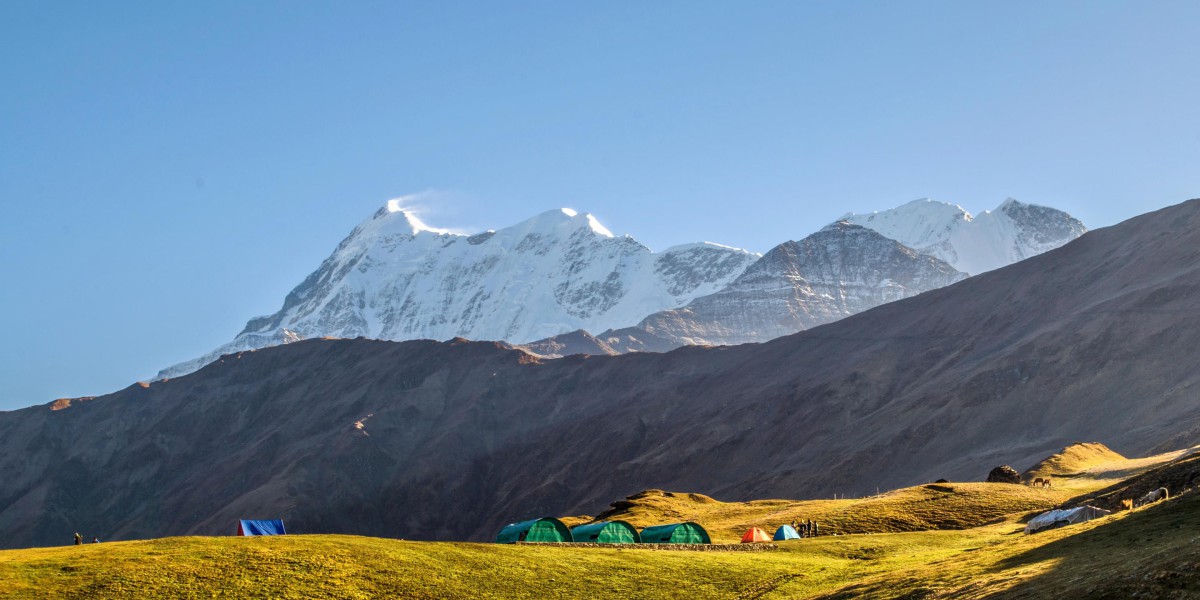Roopkund Trek Overview:
Roopkund Trek, nestled in the Indian Himalayas, is not just a hike; it's an odyssey into mystery and majesty. Picture this: a high-altitude lake, frozen for most of the year, revealing its secrets only when the ice thaws. As you ascend through lush forests and rugged terrain, the anticipation builds. Legends whisper tales of a forgotten tragedy, and your steps quicken with curiosity.
At 16,500 feet, Roopkund Lake emerges like a sapphire jewel, surrounded by snow-capped peaks. But what truly sets this trek apart is what lies beneath its icy surface. Skeletons, centuries old, eerily preserved by the icy embrace of the lake, tell a haunting story of a bygone era.
With each step of Roopkund Trek, you become a part of this narrative, traversing ancient trails and unravelling the mysteries of the past. As you stand at the edge of Roopkund, the wind whispering tales of old, you realize that this journey isn't just about reaching the summit; it's about discovering the stories etched in the heart of the mountains.
Roopkund Trek Highlights:
- Roopkund Lake: This mystical lake, often shrouded in mist, sits at an elevation of over 16,000 feet. Its icy waters hold a secret—a collection of ancient skeletons that have puzzled historians and scientists for decades. As the ice melts, the skeletons, believed to be from the 9th century, surface, sparking intrigue and speculation about their origins. The eerie yet captivating atmosphere of Roopkund Lake makes it a must-see destination for trekkers seeking both natural beauty and historical mystery.
- Trishul Peak: Towering over the landscape at 23,360 feet, Trishul Peak commands attention with its majestic presence. Its three striking summits, resembling the trident (trishul) of Lord Shiva, dominate the skyline, creating a dramatic backdrop for trekkers. Ascending towards Trishul Peak offers not only a physical challenge but also rewards with awe-inspiring vistas of snow-capped peaks stretching as far as the eye can see, making it a highlight of the Roopkund Trek.
- Alpine Meadows: The journey through the Roopkund Trek takes you across vast alpine meadows, where lush greenery carpets the undulating terrain. These meadows burst into a riot of colors during the spring and summer months, as a myriad of wildflowers bloom, painting the landscape with hues of red, blue, and yellow. Trekking through these meadows is a sensory delight, with the sweet scent of flowers filling the air and the gentle rustle of the wind through the grasses accompanying your every step.
- Bedni Bugyal: Nestled amidst the Garhwal Himalayas, Bedni Bugyal is a serene high-altitude meadow that enchants visitors with its pristine beauty. Stretching over vast expanses, this verdant paradise offers a tranquil retreat from the rigors of the trek. Here, you can witness the play of light and shadow on the rolling hills, as the sun rises and sets against a backdrop of snow-capped peaks. Camping under the star-studded sky at Bedni Bugyal is an experience not to be missed, as the silence of the mountains envelops you, transporting you to a realm of peace and serenity.
- Junargali Pass: For adrenaline junkies and adventure seekers, Junargali Pass presents the ultimate challenge. Situated at an altitude of over 16,000 feet, this narrow mountain pass tests the limits of endurance and courage. As you navigate the steep and rocky terrain, every step brings you closer to the breathtaking views that await at the summit. The feeling of accomplishment upon reaching Junargali Pass is unparalleled, as you stand triumphantly amidst the towering peaks, with the world spread out before you in all its glory.
- Brahmatal Lake: Tucked away in the folds of the Himalayas, Brahmatal Lake is a hidden gem waiting to be discovered. Surrounded by snow-capped peaks and dense forests, this pristine alpine lake captivates visitors with its ethereal beauty. The trek to Brahmatal Lake takes you through enchanting landscapes, where the silence is broken only by the occasional chirping of birds or the soft crunch of snow underfoot. As you reach the shores of the lake, you're greeted by a scene of tranquility, with the crystal-clear waters mirroring the snow-capped peaks overhead. Camping by the shores of Brahmatal Lake offers a chance to reconnect with nature and find solace in its serene embrace.
How to Reach Roopkund Trek:
By Air:
- Dehradun Airport (Jolly Grant): Fly to Dehradun Airport, which is the nearest airport to Roopkund Trek. From there, you can hire a taxi or take a bus to reach the base camp of the trek. The airport is well-connected to major cities like Delhi, Mumbai, and Bangalore.
By Road:
- From Delhi: Take a road trip from Delhi to Lohajung, the base camp for Roopkund Trek. The journey takes approximately 10-12 hours by road. You can either drive yourself or hire a taxi for a more comfortable journey.
- From Dehradun: If you're starting from Dehradun, you can take a bus or hire a taxi to reach Lohajung. The road journey from Dehradun to Lohajung takes around 8-10 hours.
By Car:
- Self-Drive: If you prefer driving yourself, you can take your own car or rent one to reach Lohajung from cities like Delhi or Dehradun. The route involves driving through scenic mountain roads, so make sure your vehicle is well-maintained and suitable for mountainous terrain.
- Taxi or Private Car Hire: Alternatively, you can hire a taxi or book a private car with a driver to take you directly to Lohajung. This option provides convenience and allows you to relax and enjoy the journey while someone else takes care of the driving.
Things to do in Roopkund Trek:
- Warm Clothing: When it comes to clothing, think layers! Start with thermal innerwear to keep your body heat trapped close to your skin. Layer up with fleece jackets or sweaters for insulation, and top it off with a down jacket to shield yourself from biting winds. Don't forget to pack plenty of woollen socks to keep your feet warm and dry throughout the trek.
- Sturdy Footwear: Your choice of footwear can make or break your trekking experience. Invest in sturdy, waterproof boots with good insulation and traction to navigate the icy terrain safely. Look for boots with ankle support to prevent injuries on uneven surfaces. Breaking in your boots before the trek is crucial to avoid blisters and discomfort along the way.
- Sleeping Bag: A high-quality sleeping bag is your best friend during cold nights in the Himalayas. Opt for a sleeping bag rated for sub-zero temperatures to ensure a restful night's sleep. Consider bringing a sleeping bag liner for extra warmth and comfort. It's also a good idea to invest in a lightweight, compact sleeping bag that won't weigh you down during the trek.
- Backpack: Your backpack is your lifeline on the trek, carrying all your essentials for survival. Choose a sturdy, waterproof backpack with padded shoulder straps and a hip belt for comfort. Look for one with multiple compartments to keep your gear organized and easily accessible. Pack essentials like water, snacks, extra layers of clothing, and personal items in your backpack, and don't forget to pack light to minimize strain on your back.
- Headlamp or Flashlight: A reliable light source is essential for navigating in the dark, especially during early morning or late evening treks. Invest in a high-quality headlamp or flashlight with long battery life and adjustable brightness settings. Consider bringing extra batteries or a portable charger to ensure your light source doesn't fail when you need it most.
- Water Bottle: Staying hydrated is key to staying healthy and energized during the trek. Bring a durable water bottle that won't freeze easily in cold temperatures. Consider using an insulated water bottle or storing your water bottle in an insulated sleeve to prevent freezing. Hydration packs are another convenient option for staying hydrated on the go.
- Snacks: Fuel your trekking adventures with high-energy snacks like nuts, chocolate, energy bars, and dried fruits. Pack snacks that are lightweight, compact, and easy to eat on the move. Aim for a balance of carbohydrates, protein, and healthy fats to keep your energy levels up throughout the trek. Don't forget to pack extra snacks to share with your fellow trekkers and spread the joy!
- Personal Medications: Be prepared for emergencies by bringing along any necessary medications and a basic first aid kit. Consider packing essentials like pain relievers, antidiarrheal medication, antiseptic wipes, bandages, blister pads, and insect repellent. If you have any pre-existing medical conditions, make sure to bring enough medication to last the duration of the trek and inform your trekking guide or group leader about your condition.
- Sun Protection: Protect yourself from the harsh rays of the sun with sunscreen, sunglasses, and lip balm with SPF. Even in cold temperatures, the sun's rays can be intense at high altitudes, leading to sunburn and windburn. Apply sunscreen generously to exposed skin, including your face, neck, and hands, and reapply regularly throughout the day. Wear UV-protective sunglasses to shield your eyes from harmful UV rays and prevent snow blindness. Don't forget to protect your lips with a moisturizing lip balm that contains SPF to prevent chapping and sunburn.



